Do you ever find yourself confused about all the different SEO terms and meanings used by experts in the industry?
Are you puzzled by SEO abbreviations like LSI, DA, and others?
Looking to better acquaint yourself with the technical SEO aspects of your website?
This comprehensive A-Z SEO glossary pulls back the curtain on all the important (and most common) SEO terminologies frequently used throughout the industry.
DOWNLOAD: A handy PDF you can save to your computer for easy reference. Includes every single SEO term contained in this glossary.
We decode the SEO jargon, defining over 100 different search-related terms, complete with helpful links.
Use the alphabetical index in the sidebar to begin browsing the glossary. Let’s go!

301 Redirect
What is a 301 redirect?
A 301 redirect is a signal that informs search engines that a web page has permanently moved from one location to a new location. 301 is the HTTP status code of the web page that has been redirected. 301 redirects should be used in the following circumstances:
- When permanently changing the URL of a page on your site to a new URL
- When your site has moved to a new domain
- The merger of two websites
- Transitioning from HTTP to HTTPS
- Recreating a piece of content or consolidating content
Done correctly, a 301 redirect will help the web page in question preserve its link equity (PageRank).
Additional Resources:
- 301 Redirects for SEO: Everything You Need to Know by Joshua Hardwick
- What I Learned From Deleting 3000+ 301 Redirects by Nick Bennett
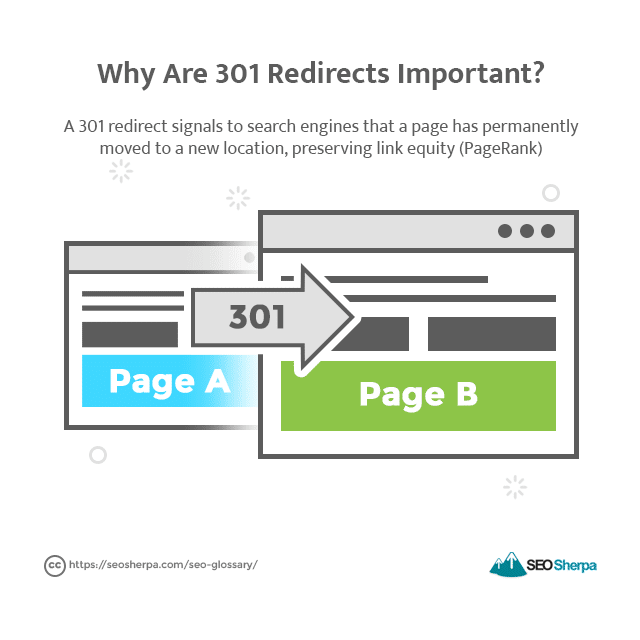
302 Redirect
What is a 302 redirect?
A 302 redirect is an HTTP response status code that redirects the visitors from one URL to another. The difference between a 302 and a 301 redirect is that a 302 redirect is temporary while a 301 redirect is permanent.
302 redirects should be used when:
- A site is having technical difficulties
- A web page is being A/B tested
- A web page is being updated
- A web page is temporarily down
- A client is providing feedback on a website redesign

404 Error Page
What can cause a 404 error?
A 404 error code occurs when a server request is made, but the requested page cannot be reached.
Like 301, 404 is also an HTTP status code. Failing to address 404 errors can be a big problem as search engines will deindex pages with a 404 error code.
This will severely hamper your site’s ranking in the search engine result pages (SERP).
Additional Resources:
- Do 404 Errors Hurt Google Crawling, Indexing & Ranking? by Jenny Halasz
- Do 404s Hurt SEO and Rankings? by Adrian Cojocariu
- What We Learned From Great 404 Error Pages by Jay Kang
- 404 Error Pages: The Ultimate Guide for SEOs by James Reynolds
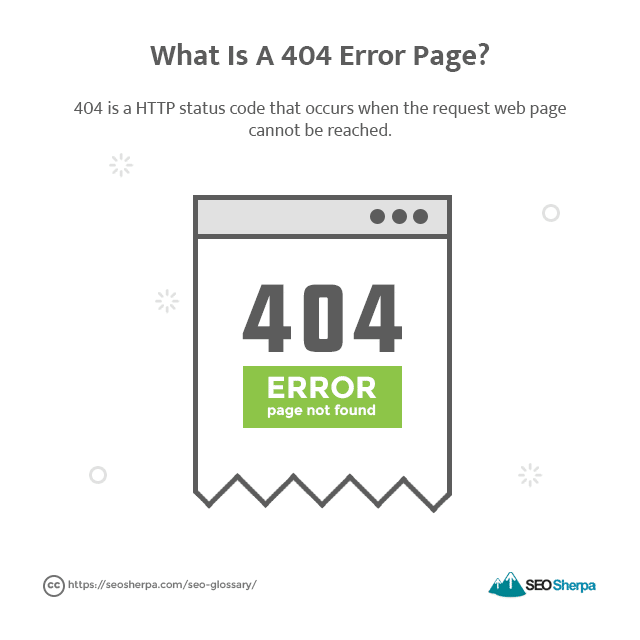

Above The Fold
What does above the fold mean?
Once a publishing term referring to the top half of the front page of a newspaper, “above the fold” now describes the portion of your website that is visible to a site visitor before scrolling down.
Optimising this section of your web page encourages users to say and interact with the content on your page.
Additional Resources:
- Why Ranking Above The Fold Matters More Than Ever by Mordy Oberstein
- 18 Stunning Examples of Above the Fold Content by Sharon Hurley Hall
Algorithm Update
What is an algorithm update?
Any changes made to a search engine’s ranking system is done through an algorithm update.
An algorithm update is a new process, formula, or program introduced by the search engine to improve search quality. Google periodically rolls out several algorithm updates throughout the year.
Depending on the purpose of the algorithm update, changes to the SERPs can be seen in a matter of hours. Broad core algorithm updates can take a few weeks for changes to occur.
Additional Resources:
- History of Google Algorithm Updates by Search Engine Journal
- A History of Major Google Algorithm Updates from 2000–Present by Moz
- Google: Algorithm Updates by Search Engine Land
Alt Attribute
Why are ALT attributes important?
ALT attributes, also known as ALT texts, ALT tags, or ALT descriptions, are the “alternative” text version of images that are displayed should your website fail to load its images or a visitor is using a screen-reading tool.
ALT attributes are assigned to images for two reasons:
- To help visually impaired visitors comprehend images on their screen-reading tool
- To help search engines better understand the image’s content, improving provide search engines with context regarding the image file, improving image SEO.
Below is an example of what an ALT attribute looks like in your HTML code:
<img src=”kangaroo.jpg” alt=”Skippy kangaroo jumping“/>Some key ALT attribute best practices include:
- Write a descriptive ALT text containing your target keyword
- Include your target keyword at the beginning of the ALT text
- Be succinct with your ALT text description
- Remove conjunctions and/or conjectures (a/an, and, if, but, etc.)
- Keep your ALT text fewer than 125 characters
- Add product or catalogue numbers in your ALT tags (for e-commerce sites)
Additional Resources:
- Image Alt Text: What It Is, How to Write It, and Why It Matters by Braden Becker
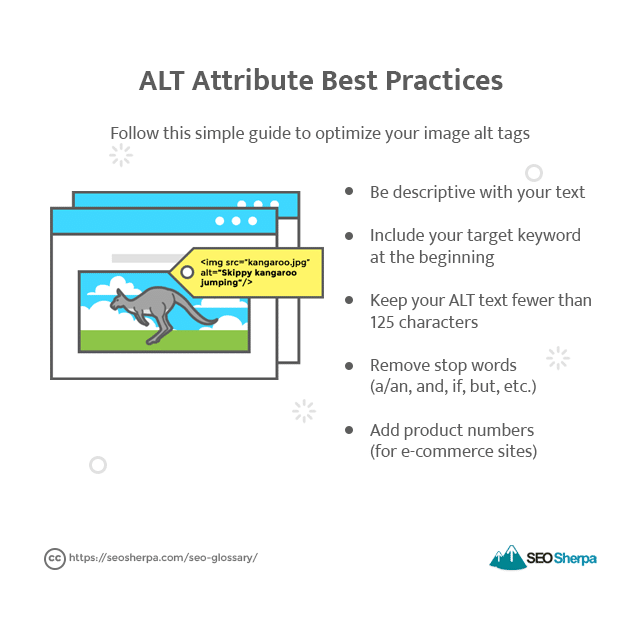
Anchor Text
Does anchor text improve SERP rankings?
The clickable text in an HTML hyperlink is known as the anchor text. An anchor text is usually blue and underlined, differentiating it from the other text on a web page.
These hyperlinks connect a web page to a topically related source on your site (internal linking) or another website (external linking).
In the HTML code, an anchor text looks like the following:
<a href=" https://seosherpa.com/image-seo/"> in-depth image SEO guide</a>Anchor texts provide search engine crawlers with more contextual information about the target page.
Anchor texts should be keyword-optimised to improve the page’s rank for topically related search queries.
Additional Resources:
- Anchor Text: A Data‐Driven Guide by Joshua Hardwick
- Why Anchor Text Diversity is Good for your Backlink Profile by Brittany Bronson
- Anchor Text: The Complete Guide for SEO’s by Karl Tablante
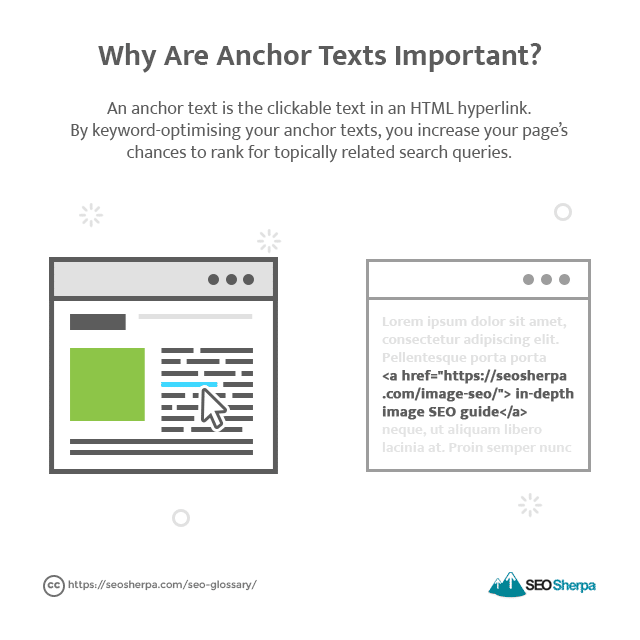
Authority
How do you increase domain and page authority?
A measurement tool used by search engines to determine a website’s or web page’s ranking strength. Authority is evaluated across different signals or factors but is typically distilled into two categories; links and content.
By creating more value-added content and high-quality external links, your web page can influence its ability to rank in search results. Displaying a high level of expertise and trustworthiness can also improve your page’s authority.
Third-party tools like Moz, Ahrefs, and Majestic allow you to estimate how much authority your web page has.
Additional Resources:
- What Is Domain Authority and How Can You Improve It? by Clifford Chi
- E-A-T and SEO: How to Create Content That Google Wants by Ian Booth
Average Time On Page
What is average time on page?
Average Time on Page is a Google Analytics metric that measures how long a visitor stays on a particular page. Average Time on Page is determined by calculating the time difference between timestamps.
Additional Resources:
- Misunderstood Metrics: Time on Page by Mike Sullivan
- 21 Ways to Improve The Average Time on Page by Kiera Abbamonte
- 11 Hacks to Increase Visitors’ Average Time by Noumaan Yaqoob

Black Hat SEO
What is black hat SEO?
Black hat SEO is shady optimisation tactics and shortcuts that are deemed unethical or violates a search engine’s webmaster guidelines.
Some examples of typical black hat SEO tactics are:
- Keyword stuffing
- Cloaking
- Sneaky redirects
- Doorway pages
- Hidden texts or links
- Link schemes
- Article spinning
- Content automation
- Rich snippet markup spam
- Private blog networks (PBNs)
While black hat SEO practices may work for some time, attempting to deceive search engines will result in a manual action. Penalties can range from a downgrade of rankings to complete delisting your website.
Additional Resources:
- Google Webmaster Guidelines
- Bing Webmaster Guidelines
- Eight Black Hat SEO Techniques That Are Killing Your Rankings by James Reynolds
Bounce Rate
How to measure and assess your site’s bounce rate
Bounce rate is an engagement metric analysing how many single-page visits (or sessions) leave a web page without performing a measurable action.
Bounce rate is calculated by taking the total number of single-page visits which left without a single interaction divided by the total number of visitors to a web page.
Bounce rate is displayed as a percentage on web analytics platforms like Google Analytics.
A high bounce rate is indicative:
- Bad content
- Poor user experience
- Technical errors
- Speed issues
Additional Resources:
- Understanding bounce rate in Google Analytics by Annelieke van den Berg
- What Is Bounce Rate? (And How Can I Fix Mine?) by Amanda Zantal-Wiener
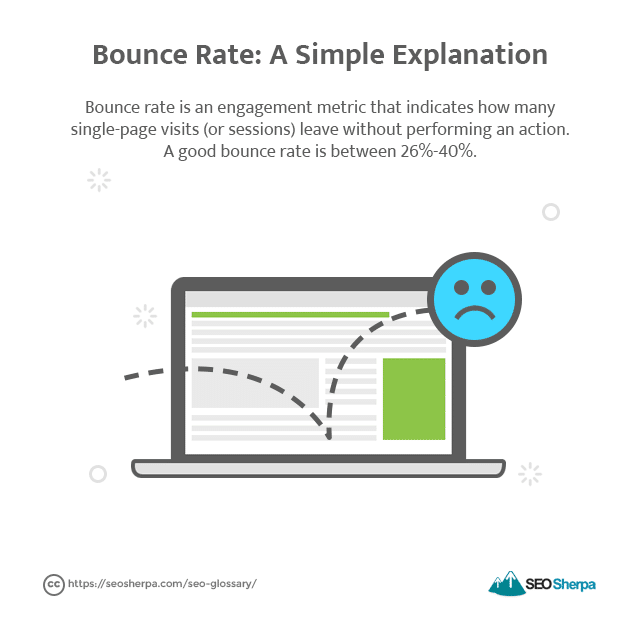
Bots
How do search engines crawl and index websites?
Bots are computer programs written by search engines like Google and Bing to crawl the web.
These bots or web crawlers automatically scan websites to gather information for the search engine’s index. Bots crawl web pages by following links and sitemaps.
To keep a search engine’s database up to date, bots continuously travel from page to page via links to discover if changes have occurred to an existing site or if a new site has been created.
The more often a site creates and updates its content, the more often crawlers will visit the site.
Additional Resources:
- 10 Ways to Think Like Googlebot & Boost Your Technical SEO by John McAlpin
- Crawl speed: How to get Google to crawl your site faster by Joost de Valk
- 10 Ways to Get Google to Index Your Site by Joshua Hardwick
Branded Keywords
What is a branded keyphrase?
A branded keyword (or brand term) is a search query that includes your company’s name or a close variation.
A search query that doesn’t have a brand name but still closely relates to the company’s product or service is known as a non-branded keyword.
“Buy iphone” or “iphone reviews” are an example of a branded search term as they highlight Apple’s specific product (iPhone). Examples of non-branded search terms include “most popular smartphones” or “best selling mobile devices.”
Additional resources:
- Find All Your Branded Keywords In Seconds by Andy Crestodina
- Targeting Branded vs. SEO Keywords: Which Should You Focus On? by Eric Siu
Broken Link
What are broken links?
Broken links are links that lead to a web page that is not available. There are several reasons why a link may not work:
- A web page was moved with a 301 or 302 redirect
- A web page is temporarily unavailable
- The web page’s URL structure was changed
- The linked web page has been removed or no longer exists
When a visitor encounters a broken link, a 404 page error will be displayed. Broken links can negatively impact your SEO efforts, diminishing the quality of your website in the SERPs.
Additional resources:
- How to Find and Fix Broken Links by Joshua Hardwick
- A Guide to Broken Link Building by Kim Kosaka
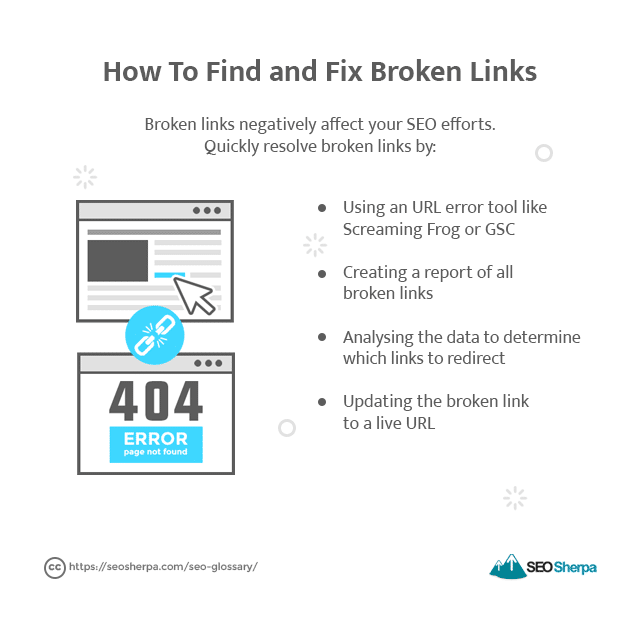

Canonical URL
What is a canonical URL?
When your website has two (or more) similar web pages, duplicate content issues could occur. These issues can make it hard for search engines to determine which page to show more prominently in search results.
A canonical URL is an HTML link tag, used to address these duplicate issues, so search engines know which URL is the preferred one.
You can dictate which URL is the canonical one by using the HTML attribute of rel=”canonical” and placing it in the <head> section of the web page’s HTML source code.
Additional Resources:
- Canonical URLs: A Beginner’s Guide to Canonical Tags by James Brockbank
- Canonical Tags — 2020 SEO Best Practices by Moz
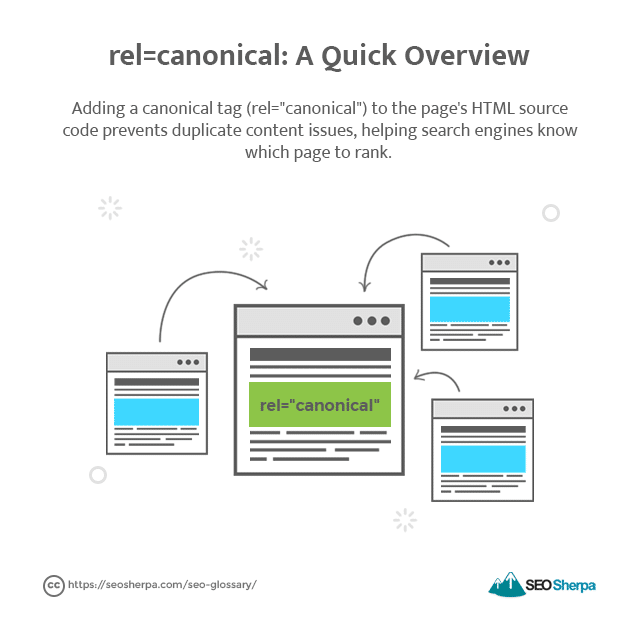
Clickbait
Is clickbait a black hat SEO strategy?
Clickbait is the act of misrepresenting your content to attract attention and trick people into clicking a link to your website. Clickbait makes use of falsely advertised hyperlinks or images to increase visits to web pages.
Clickbait is considered a black at SEO tactic as it misleads the site visitor and diminishes brand trust. Both can result in high bounce rate which negatively affects search rankings.
Additional Resources:
Click-Through-Rate
Why should you measure click-through-rate?
Click-through-rate (CTR) is a metric, expressed as a percentage that is calculated by comparing the total number of impressions to clicks in an organic or paid search result.
CTR is an important measurement tool as it indicates which marketing/paid campaigns are effective. Certain factors and SEO elements like keywords, copy, CTA, imagery, and ad positioning can affect CTR.
Additional Resources:
- What Is Click-Through Rate (CTR)? [Guide] by WebFX
- Understanding the Meaning of Click Through Rate by Brandi Zatorski
Cloaking
Should you practice cloaking?
A black hat SEO technique, cloaking is the practice of serving a different version of content to a user than what a search engine bot sees. Cloaking is done to trick search engines into inflating a site’s ranking in the SERPs.
There are several different methods of cloaking that can be performed:
- User-Agent Cloaking
- IP based cloaking
- JavaScript cloaking
- HTTP_REFERER cloaking
- HTTP Accept-language header cloaking
As cloaking is a violation of a search engine’s webmaster guidelines, any attempt to game search engines via cloaking will result in the website being delisted from the search engine’s index.
Additional Resources:
- What is Cloaking & Is All Cloaking Evil? by Ann Smarty
Conversion Rate Optimisation
What is conversion rate optimisation and how does it work?
Conversion rate optimisation or CRO is the process of tailoring your website (and its web pages) so that visitors are encouraged to perform a conversion action that’s valuable to your business.
By optimising your website based on user behaviour, your business increases the chances of visitors turning into customers.
These conversion actions vary by business and industry but typically include:
- Subscribing to your email newsletter
- Buying your product or service
- Filling out a lead generation form
- Clicking on an ad
- Trial account setup
- Demo request
Additional Resources:
- The Beginner’s Guide to Conversion Rate Optimization (CRO) by Ben Cotton
- What is conversion rate optimisation (CRO)? by Rebecca Sentance
Crawling
How do search engines crawl your website?
Search engines employ a team of robots called crawlers or spiders to crawl or read a website’s content (visual and text) by following the site’s links (both internal and external).
The content that these crawlers find is stored and organised in a database called a search engine index.
Additional Resources:
- What is Crawl Budget? And Why Does It Matter for SEO? by Brian Dean
- Crawl speed: How to get Google to crawl your site faster by Joost de Valk
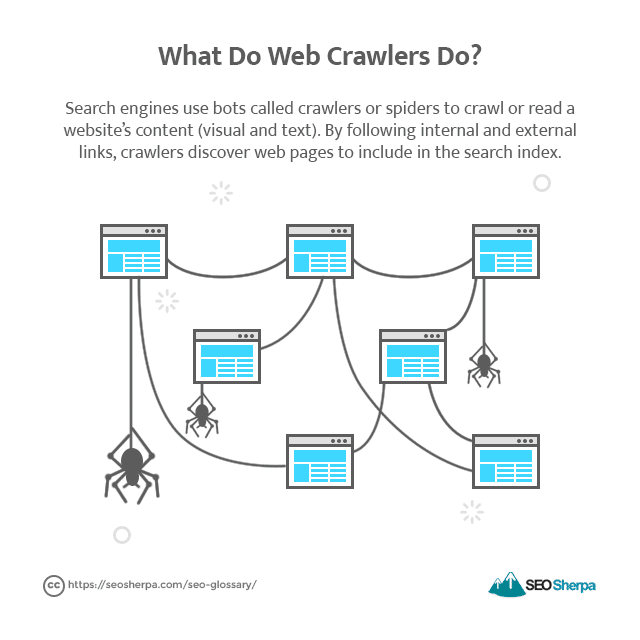
Crawl Budget
What is a crawl budget?
A technical SEO term, crawl budget refers to how many pages on your site Google’s bots will crawl within a given time frame. Crawl budget is determined by:
- Crawl rate limit: A site’s maximum fetching rate before user experience degrades
- Crawl demand: the importance of the web pages based on factors like popularity and staleness
Additional Resources:
- What Crawl Budget Means for Googlebot by Google
- All About Crawl Budget Optimization by Botify

De-indexed
Why has my website been de-indexed from Google?
De-indexing is the process of getting a website or web page removed from a search engine’s database or index. Becoming de-indexed means that a website will no longer appear in search results.
This removal can be temporary or permanent.
There are several reasons why a site may get de-indexed:
- A violation of the webmaster’s guidelines
- A violation of the search engine’s quality guidelines
- A manual action by the search engine
- A webmaster has purposely edited the web page’s HTML to “noindex”
Additional Resources:
- Why is my page missing from Google Search? by Google
- De-indexed by Google? Here’s How to Recover by Adam Heitzman
- Crawled — Currently Not Indexed: A Coverage Status Guide by Christopher Long
Directory
Are web directories still relevant for SEO in 2021?
Much like the phone book or the Yellow Pages, a directory is an online database of websites. In the early days of the internet, before search engines, directories were used to help users find and discover websites.
These aggregated lists vary by category and niche.
Over time, the use of web directories experienced widespread abuse as more and more websites used directories as spammy link submission sites, artificially manipulating search rankings.
To combat this abuse, Google and other search engines built algorithms that penalised spammy link directories, devaluing the use of directories.
While directories have declined in popularity, links from directories still provide a small ranking boost, provided the directory is reputable and relevant to the website’s niche.
Additional Resources:
- 21 Web Directories That Still Have Value by Amelia Willson
- Web Directory Link Building by Matthew Woodward
Disavow Links
When should you disavow links?
When a website receives backlinks from an untrusted source or spammy site, that site might be subject to a manual action from a search engine like Google.
To avoid violating a search engine’s guidelines, a website may choose to disavow certain links to protect its reputation and ranking position from being devalued by a search engine.
There are specific ways a website can mitigate backlink risks and disavow links. One is to contact the webmaster of the external site and ask them to remove the link.
The other way is to notify Google by using the Google Disavow Tool. This Disavow Tool will tell Google which external links are harmful and should be ignored.
Additional Resources:
- Your Start-to-Finish Guide to Using Google’s Disavow Tool by Marie Haynes
- When You Should and Shouldn’t Use the Google Disavow Tool by Adrian Cojocariu
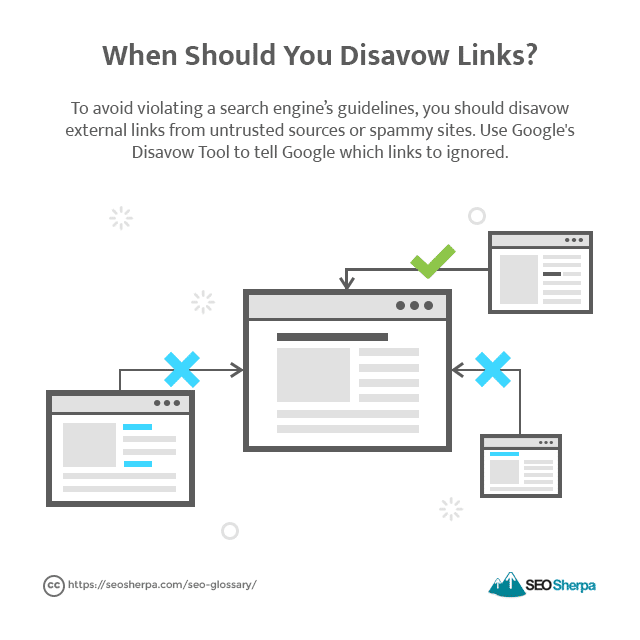
Dofollow
What is a dofollow link?
Dofollow links are links that search engines use to pass authority between websites known as link equity.
As links are an essential ranking factor, the more dofollow links a site has from high quality, authoritative, and relevant sites, the higher the target’s PageRank is.
Unlike nofollow links, dofollow links do not have a rel attribute. In HTML, a dofollow link looks like:
<a href="https://seosherpa.com">organic SEO agency in Dubai</a>Additional Resources:
- Do Outbound Links Affect SEO? by WebFX
- What is the Best Dofollow vs Nofollow Ratio? by Michael Chibuzor
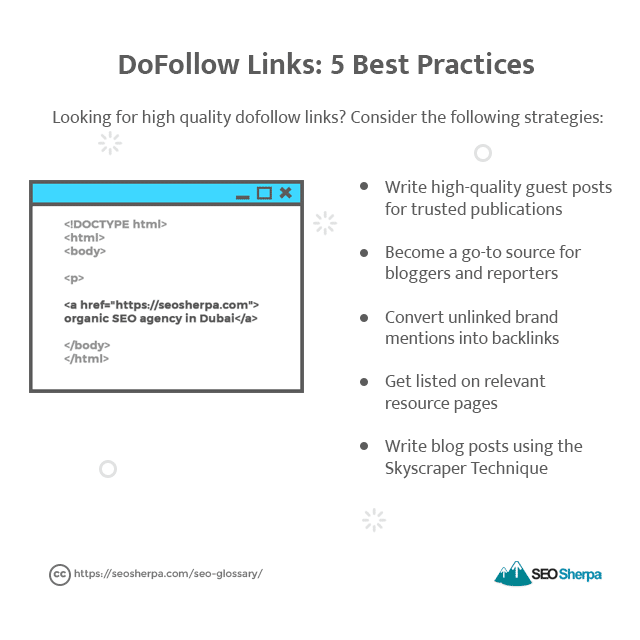
Domain
What is a domain name?
A domain is the unique identifier of your website.
Every device or computer network is provided with an Internet Protocol (IP) address, a unique numerical label like 172.16.254.1, used to identify that particular device or system.
Because this string of numbers is difficult to memorise, a text web address is used. Much like a house address, your domain is your business’s online address. Domain consist of two parts:
- Domain name: the unique alias or identifier of your business (Ex: seosherpa)
- Top-level domain: a domain extension used to classify the website (.com, .org, .edu, .gov, etc.)
Additional Resources:
- How To Choose A Domain Name by Rand Fishkin
- Choose an effective domain name by Google
- How to Choose a Domain Name: The Complete Guide by James Reynolds

Domain Authority
What is domain authority and how does it affect my website?
A ranking metric developed by Moz, Domain Authority (DA) predicts how well a site will rank in the SERPs.
The DA score evaluates several factors like the total number of inbound links and linking root domains to calculate a single DA score that ranges from 0 to 100.
The higher a site’s DA score is, the greater ability it has to rank.
Domain Authority should not be confused with website authority, which determines the “strength” of a given domain. DA is a comparative metric, meaning it does not affect Google’s SERPs.
Additional Resources:
- How to Use Domain Authority 2.0 for SEO by Cyrus Shepard
- How Do I Improve My Domain Authority (DA)? by Dr. Peter J. Meyers
Dwell Time
Why does dwell time matter for SEO?
Dwell time is the amount of time search users spend on a page that they’ve clicked on from the SERPs before returning. Higher dwell time is indicative that the content on the page satisfied the searcher’s needs.
Dwell time should not be confused with Bounce Rate (the percentage of visitors that visit a web page and leave without taking action).
Dwell time is also different from Time on Page which is the amount of time a user spends on a web page that they clicked on from any source such as social media, email, another web page etc.
Additional Resources:
- Dwell Time in SEO: All You Need to Know by Sidra Condron

E-A-T
What does E-A-T stand for?
An acronym that stands for Expertise, Authority, and Trust, E-A-T is a Google quality rating that scores the quality of a web page.
A page with relevant, high-quality content will be rewarded with better search rankings. Low-quality pages will lose visibility in the SERPs.
Additional Resources:
- E-A-T and SEO by Marie Haynes
- 5 Things You Can Do to Improve Your E-A-T Rating by Manish Dudharejia
Exact Match Anchor Text
Are exact match anchor texts bad for SEO?
An exact match anchor text refers to when the anchor text includes the precise keywords of the page being linked. Too many exact match anchor text links on your website can trigger a Google penalty.
Additional Resources:
- What is Anchor Text? Everything You Need to Know by Julia McCoy
- Advanced Approach to Selecting Anchor Text by Kevin Rowe
External Link
What is an external link and why is it important for SEO?
Hyperlinks that direct users to a different domain than its source is considered an external link. External linking is important as outbound links increase referral traffic to your website.
The more external links you have from authoritative sites, the higher your website’s ranking becomes.
Additional Resources:
- How to Track Outbound Links with Google Analytics by Julius Fedorovicius
- Do outbound links matter for SEO? by Michiel Heijmans

Featured Snippets
How to compete for Google’s featured snippets
Featured snippets are a SERP feature that displays a web page’s content is a special box above the organic search results. A featured snippet is also called position 0 because of its placement in the SERPs.
Featured snippets are answer boxes that provide search users with direct answers to their query without ever having to click on a link or URL in the search result.
There are four types of featured snippets that get displayed in the search results:
- Paragraph
- List
- Table
- Video
Additional Resources:
- How Google’s featured snippets work by Google
- 15 Featured Snippet Strategies to Rank in Position Zero by Karl Tablante
- How to Optimise for Google’s Featured Snippets in 2020 by Michal Pecánek
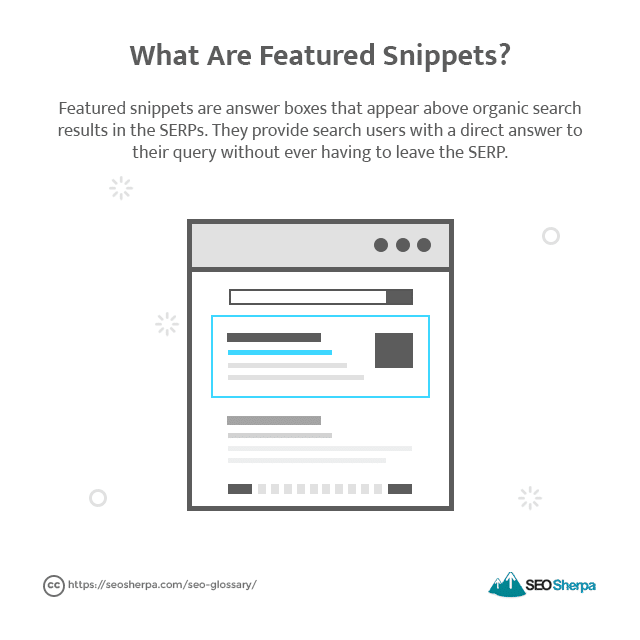

Google My Business
What is Google My Business and why do I need it?
Google My Business (GMB) is a free tool provided by Google to help businesses and organisations generate a business profile for Google Search and Google Maps.
This free tool provides businesses with more oversight on how their business appears in the SERPs.
By claiming your company’s GMB listing, you can better control how your business appears for local search queries (example: pizzeria near me).
Additional Resources:
- How To Get Your Business On Google by Karl Tablante
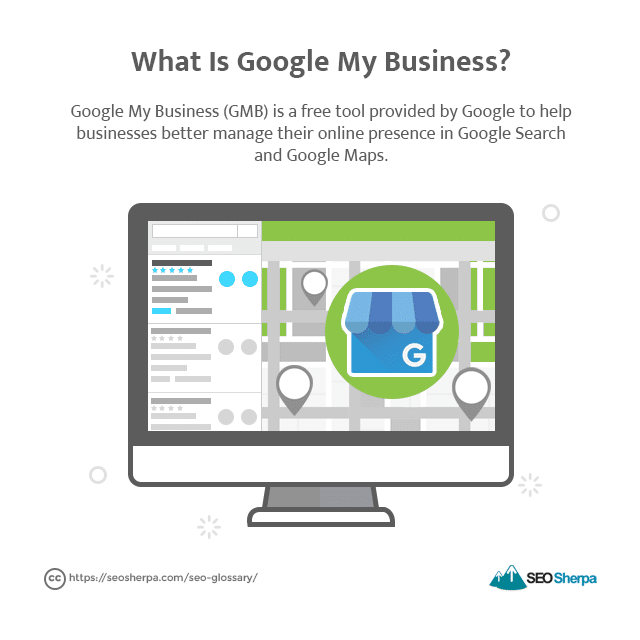
Google Search Console
What is Google Search Console?
Google Search Console (GSC) is a free service provided by Google. Google Search Console offers websites access to data and tools that help site owners optimise their site for Google search results.
GSC lets webmasters:
- Fix indexing problems
- Submit sitemaps and URLs for crawling
- View Google Search traffic data
- Identify site issues like mobile usability
Additional Resources:
- The Ultimate Guide to Google Search Console in 2020 by Aja Frost
- How to Use Google Search Console to Drive 28% More Search Traffic by Neil Patel
Grey Hat SEO
Do grey hat SEO tactics go against a webmaster’s guidelines?
Grey hat SEO is the blurred line between white and black hat SEO. Grey hat SEO uses “ill-defined” or “ill-advised” SEO practices and strategies that don’t necessarily violate a search engine’s guidelines but are still risky.
Some grey hat SEO techniques include:
- Domain grabbing
- Link exchange
- Social bookmarking
- Guest blogging
Additional Resources:
- The fuzzy boundary between Grey and Black Hat SEO by Jordan Koene
- Gray Hat SEO in 2019: Is it Still Worth It? by Sean Si

Headers
What do headers do?
Headers are HTML elements that are used to structure your website’s content, helping users and search engines better understand the relevancy of your content.
Headers are also used to improve readability, improve your site’s accessibility, and support your SEO efforts. Because header tags are structured hierarchically, they rank in order of importance, from H1 to H6.
Additional Resources:
- SEO basics: How to use headings on your site by Jono Alderson
- Header Tags: A Simple Guide Heading Tags For SEO by James Reynolds

Homepage
What is a homepage?
The introductory or root page of a website, a site’s homepage acts as a navigation hub.
A well-structured homepage provides a clear navigational path to other web pages on your site, helping visitors land on your site’s most important and high-value pages.
Additional Resources:
- Homepage SEO: Does it exist? by Michiel Heijmans
- Why You Shouldn’t Rank Your Homepage by Clayton Johnson
HTML
What does HTML stand for?
Hyper Text Markup Language (HTML) is the standard markup language used to create web pages.
HTML allows users to organise and format their website’s metadata and content. HTML makes use of code structures (attributes and elements) to annotate and differentiate the various content on a web page.
Additional Resources:
- HTML Introduction by W3Schools
- HTML tags you can’t do without in 2020 by Andrew Shipp

HTTP & HTTPs
What is the difference between HTTP and HTTPS?
HTTP (Hypertext Transfer Protocol) and HTTPS (Hypertext Transfer Protocol Secure) are a set of rules and standards that allow information to be transmitted on the internet and enable web browsers and serve to communicate between one another.
The main difference between HTTP and HTTPS is that HTTPS is the secure version of HTTP.
HTTPS uses the SSL/TLS protocol, creating a secure encrypted connection between browser and server. This allows websites to protect sensitive information and secure transactions.
Additional Resources:
- How to convert HTTP to HTTPS: A quick guide [Infographic] by Michael O’Neill
- What is HTTPS: The Definitive Guide to How HTTPS Works by Brian Harnish
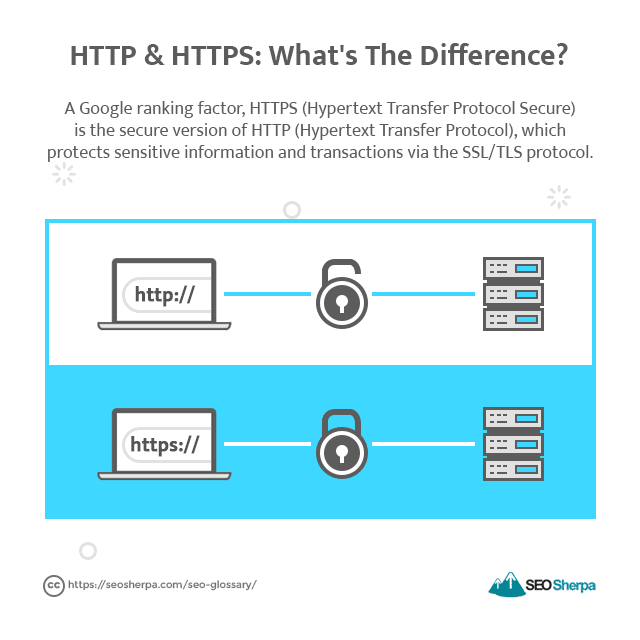

Image SEO
How can my images rank for Google Search?
Image SEO refers to the practice of optimising images to rank high in Google Images. Images improve their discoverability, crawlability, indexability, and rankability by:
- Choosing the right file type
- Scaling images to optimum proportions
- Optimising file names
- Reducing file size
- Writing SEO-friendly ALT text
- Leveraging image sitemaps
- Serving responsive images
- Using lazy loading
Additional Resources:
- Google Image best practices by Google
- Image SEO: The Ultimate Step-by-Step-Guide by James Reynolds
Inbound Link
What is an inbound link?
Links that direct to your website from a third-party site or domain is known as inbound links or backlinks. Search engines view inbound links as a vital ranking signal.
More backlinks from authoritative domains back to your site results in higher rankings. Backlinks that come from spammy or untrusted domains should be disavowed to avoid any ranking penalties.
Additional Resources:
- How Inbound Links Help Local SEO by Greg Gifford
- Five sure-fire strategies to build inbound links by Christopher Porteous
Indexability
How do I improve my site’s indexability?
Indexability determines how many individual URLs on your site can be indexed by a search engine’s bots. Putting “site:” in front of a URL can show you which web pages are currently indexed by a search engine.
Additional Resources:
- Technical SEO Indexability Checklist by Christina Perricone
- 10 Steps for Checking Your Website’s Indexability by Eva Wagner
- 5 Steps to Boost Your Site’s Indexability by Irina Hey
Internal Link
How do internal links differ from external links?
Hyperlinks that point to a different page on the same domain or subdomain are known as internal links. Internal links are essential as they:
- Help search engines find and index content on your site
- Guide visitors to high-value pages, improving site usability
- Passes link value from one page to another
Both external and internal links play a role in a robust link profile.
Additional Resources:
- Internal Linking for SEO: best practices, strategies, axioms by Kevin Indig
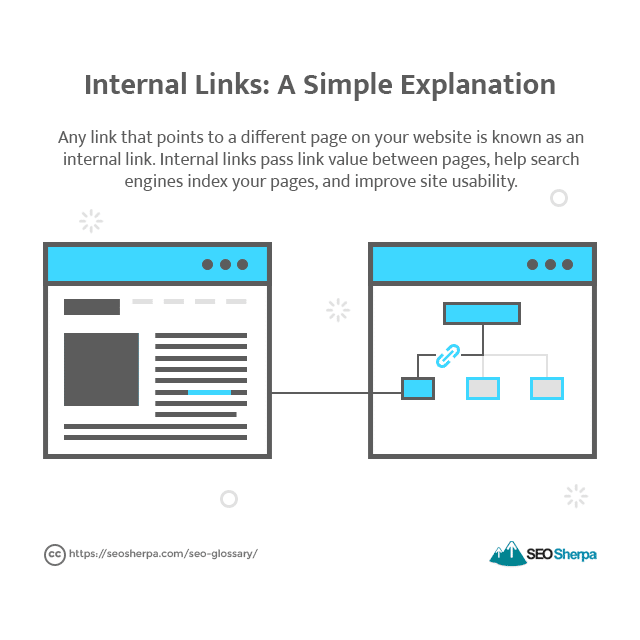

JavaScript
How does JavaScript affect SEO?
A type of programming language, JavaScript is used by websites to display complex features like interactive maps and animations.
JavaScript is used in conjunction with two other web technologies, HTML and CSS, to build dynamic websites and improve user experience.
Additional Resources:
- JavaScript SEO Best Practices Guide for Beginners by Steven van Vessum
- All You Need to Know About JavaScript SEO by Serge Bezborodov
- JavaScript Crawling for Better & More Accurate Site Audits by Cornelia Cozmiuc


Keyword Cannibalisation
What is keyword cannibalisation?
Keyword cannibalisation occurs when pages on your website compete against each other for the same focus keywords.
Keyword cannibalisation can ruin SEO efforts as competing pages in the SERPs can lower rankings or diffuse traffic, resulting in diluted page authority and fewer conversions.
Additional Resources:
- How to Spot and Fix Keyword Cannibalization by James Brockbank
- The Definitive Guide to Keyword Cannibalization by Matt Diggity
Keyword Density
What is a good keyword density?
Keyword density is an aspect of keyword optimisation. It refers to how frequently keywords or keyword phrases appear on a web page relative to the total text on the page.
If you have a web page with 1000 words and 20 of those words were your target keywords, your keyword density is 2%.
Additional Resources:
- Keyword Density Analysis Tool by Internet Marketing Ninjas
- Keyword Density: What It Is and How to Calculate It by Jennifer Yesbeck
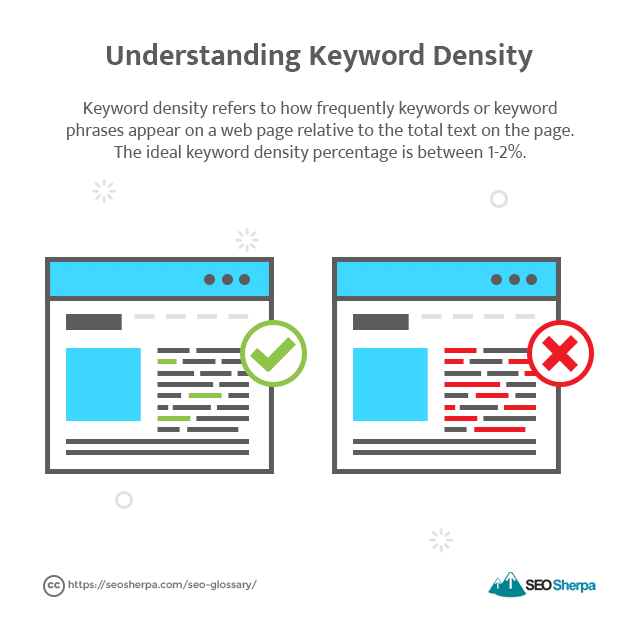
Key Performance Indicators
What are KPIs and what are they used for?
Key performance indicators (KPIs) are quantifiable metrics used to measure the effectiveness and performance of an SEO or marketing campaign against key business objectives.
KPIs can vary according to the business objectives and the goal of the campaign.
Examples of crucial KPIs to track when running an SEO campaign include:
- Click-through-rate (CTR): the number of impressions (organic or paid) that results in a click to your site, displayed as a percentage
- Page load time: the amount of time it takes for a web page to load
- Organic sessions: how many visits your website receives from the SERPs
- Average session duration: the average length of a site visit
- Bounce rate: the percentage of users who immediately exit your site after loading the page
Additional Resources:
- 10 KPIs to track your SEO performance by Adelina Karpenkova
- Track These SEO Metrics & KPIs For SEO Success by Gabby Regalbuto
- 5 common SEO KPIs you should be ignoring by Helen Pollitt
Knowledge Panel
How do you get a knowledge panel in Google’s SERPs?
A type of Google SERP feature, the Knowledge Panel is a special information box that appears on the right side of Google’s search results page.
Knowledge Panels are designed to help search users learn quick information about specific search queries of people, places, organisations, and things.
Knowledge Panels are automatically generated from Google’s Knowledge Graph.
Additional Resources:
- How to get a Knowledge Panel for your brand by George Nguyen
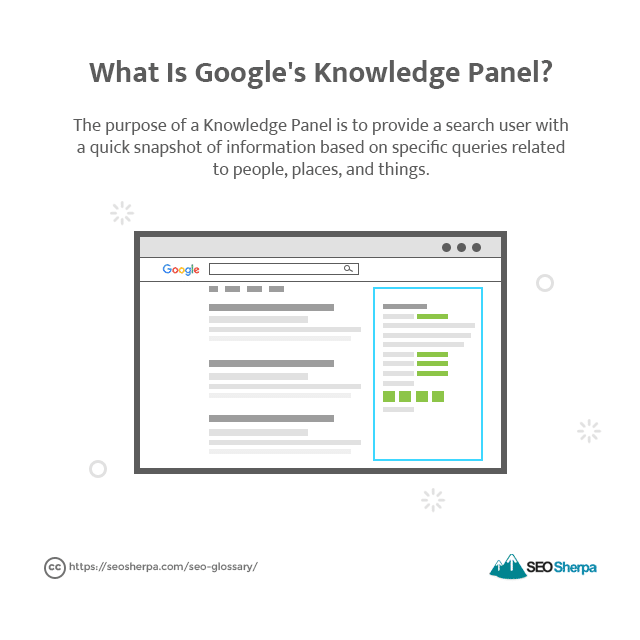

Landing Page
What is a landing page?
Landing pages are standalone web pages built for a specific marketing campaign with the sole focus of converting visitors into leads.
Landing pages are called so because visitors “land” on this type of page by clicking on a link from various sources like emails and paid ads.
Additional Resources:
- What Is a Landing Page? All Your Questions, Answered by Ellie Mirman
- 9 Essentials of a High Converting Landing Page by Neil Patel
Latent Semantic Index
What role does LSI keywords play in SEO?
Latent semantic indexing (LSI) is an information retrieval system used to find hidden relationships between character strings.
In SEO, LSI uses keywords to build associations and connections between words. LSI keywords are semantically related keywords or phrases that share the same context of the primary keyword.
Online tools like LSI Graph and Google’s “Related Searches” are some ways to find LSI keywords.
Additional Resources:
- How to Use Latent Semantic Indexing Keywords by David Oragui
- What Is Latent Semantic Indexing & Why It Won’t Help Your SEO by Clark Boyd
- LSI Keywords: What are They and Do They Matter? by Joshua Hardwick
Link Building
What is link building in SEO?
Link building is the practice of acquiring backlinks (or hyperlinks) from other websites to your own.
Backlinks act as a vote of confidence. A high amount of votes provides Google with a signal that your website is a quality resource that deserves to be high up in the SERPs.
Additional Resources:
- The Good, the Bad, & the Ugly of Link Building by Moz
- 21 ACTIONABLE Link Building Strategies for 2020 by Robbie Richards
- 19 Timeless Link Building Strategies for 2021 & Beyond by Karl Tablante
Link Equity
How do I build link equity for my website?
Link equity, sometimes called link juice, is the value of a link. Link equity is related to PageRank, making it an important ranking signal in determining a page’s SERP ranking position.
Certain links pass more value than other links. The amount of value that a link gives is determined by several factors such as linking site’s authority, link’s topical relevance, link’s location on the page, HTTP status, and more.
Additional Resources:
- Understanding and Harnessing the Flow of Link Equity by Rand Fishkin
- Want More Link Juice? Here’s an Easy Way to Get It by Ken Lyons
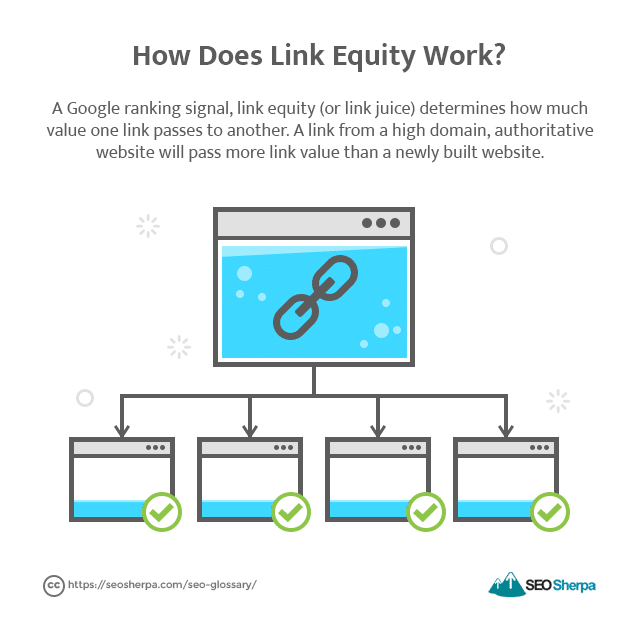
Link Profile
How does my website keep a clean link profile?
The total number of inbound links that point back to your site is known as link profile.
Each of the links in this dataset has a rippling effect. The inbound links in your link profile determine things like your site’s authority and ranking in the SERPs.
The more organically-acquired, high-authority backlinks your link profile has, the more diverse it will seem to search engines, positively influencing search rankings.
Additional Resources:
- 7 Elements of Your Link Profile That Drive SEO Results by Jeff Previte
- Backlink Analysis: How to Spot Quality and Toxic Backlinks by James Brockbank
Local Pack
What is Google’s local pack?
Another Google SERP feature, the local pack or local snack pack is a collection of the three most relevant businesses that most closely answer a specific local search query.
The local pack is displayed as a response to local search intent.
Local pack results are pulled from Google’s Google My Business directory, meaning that a business can only be displayed as part of the local pack when that business has claimed their GMB profile.
Additional Resources:
- The Local SEO Checklist: Your Ticket Into The Snack Pack by Sean Si
- How to Rank #0 in Google with Local Packs by StableWP
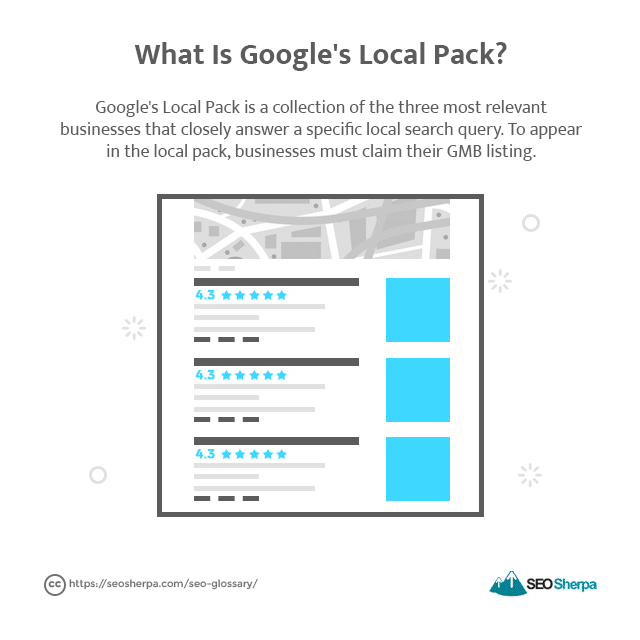
Local SEO
How does local SEO differ from standard SEO?
Local SEO focuses on optimisation strategies that enable your products or services to rank high for search queries with local intent (example: best coffee shop near me).
Unlike standard SEO, local SEO makes use of local search tools like Google My Business to target audiences in your local geographic area.
Additional Resources:
- A Step-By-Step Guide To Optimising Your GMB Listing by James Reynolds
- SEO vs. Local SEO: Spilling the Tea on Must-Know Differences by Emily Carter
Long-Tail Keyword
What does long-tail keywords really mean?
Long-tail keywords are low volume and highly-focused search queries. Unlike broad and generic search queries, these types of searches are niche-oriented and have little competition.
Long-tail keywords play an essential role in your SEO efforts as these lengthy search terms are used by search users looking to perform an action like purchase a product or subscribe to an email list.
Additional Resources:
- 5 Best Long-Tail Keyword Generator Tools by John Hughes
- How to Identify the Best Long-Tail Keywords by Syed Balkhi
- Long Tail Keywords and SEO by Roger Montti
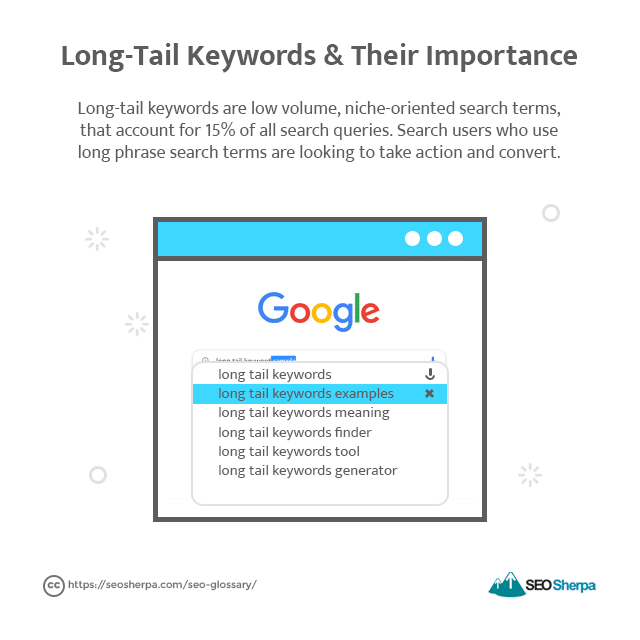

Manual Action
What do I do if my site receives a manual penalty from Google?
A manual action is a penalty leveraged by Google on websites that violates the search engine’s webmaster guidelines. Most manual actions are issued because the website has attempted to manipulate Google’s search index.
Manual action will result in the website being demoted in rankings or removed from search results.
Additional Resources:
- The Complete List of Google Penalties & How to Recover by Chuck Price
- How to Recover from a Google Penalty by Rebecca Stickler
Metadata
What is metadata?
Metadata is HTML information regarding your web page. This information is used by search engines to determine important information concerning relevant search queries.
Some essential metadata for SEO includes title tag, meta description, and alt text.
Additional Resources:
- SEO: Why Is Metadata Important? by Jill Kocher Brown
- Meta Tags: The Definitive Guide to Meta-Data for SEO (2021) by James Reynolds
Meta Description
Do meta descriptions affect SEO?
A meta description is a short summary that can be seen in the SERPs directly below your page’s title and URL. This description can be written in your site’s content management system as an HTML tag.
An example of a meta description in the HTML code looks like the following:
<meta name="description" content="A short description of the page’s content."/>The best type of meta description includes your focus keyword, adds a relevant call-to-action, is meaningful and descriptive, and is 140-160 characters long, which is roughly one to two sentences.
Additional Resources:
- Does The Meta Description Tag Affect SEO? by Adrian Cojocariu
- How to create the right meta description by Michiel Heijmans
- How to Write the Perfect Meta Description by James Reynolds


Natural Link
What’s the significance of a natural link?
A natural link is a type of backlink that was generated naturally without any form of link building.
Natural links occur when other websites link back to yours because they believe that your content is valuable and insightful for their audiences.
Natural links are considered the best type of backlinks as they are unbiased votes of confidence or endorsements from other sites.
Nofollow
What is a nofollow link?
Nofollow is an HTML link attribute that helps search engines understand which links in your link profile are not endorsed by your site and should be ignored.
Nofollow links still work like any other link, meaning users can still copy or click the link. The HTML code of nofollow links has the rel= “nofollow” tag.
Nofollow links are important aspects of your link profile as it allows your site to combat against spam sites trying to manipulate search engines.
Additional Resources:
- Qualify your outbound links to Google by Google
- Nofollow links are not useless by Pratik Dholakiya
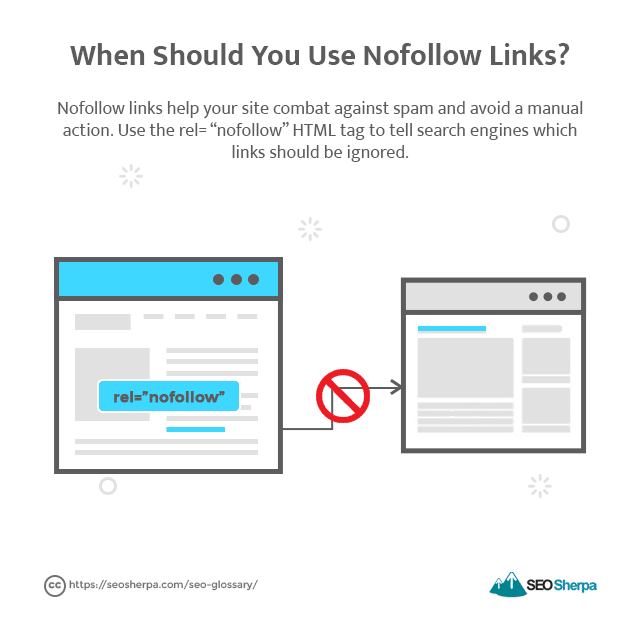

Off-Page SEO
What is off-page SEO and why is it important?
Any SEO activity that occur outside of your website is known as off-page SEO. While link building is synonymous with off-page SEO, there are other strategies websites can use to drive organic traffic to their website.
Key off-page SEO strategies websites can try include:
- Building NAP citations
- Guest posting
- Guest appearances (podcast/speaking opportunities)
- Claiming your Google My Business listing
- Generating product and brand (via Google) reviews
- Social shares
Additional Resources:
- Off-Page SEO Ranking Factors [2020] by Moz
- Off-Page SEO: The Definitive Guide by Brian Dean
On-Page SEO
What is on-page SEO and why is it important?
On-page SEO is the practice of optimising a website’s elements to improve its search rankings. On-page factors are multi-faceted, covering content and technical (HTML) optimisation.
On-page SEO is important as a crawlable and user-friendly website is needed to rank in the SERPs. Key on-page SEO actions your website can perform include:
- Optimising your site’s metatags
- Writing high-quality, relevant content
- Improving site load times
- Using HTTPS
- Using image best practices
- Making your site mobile-friendly
Additional Resources:
- On-Page SEO Ranking Factors [2020] by Moz
- 10 Essential On-Page SEO Factors You Need to Know by Anna Crowe
Organic Search Results
What does organic search results mean?
Organic search results are the free listings provided to businesses or organisations by a search engine. These results are determined by how closely a site’s content matches the search query.
The more relevant (among other algorithm factors) that the content is to a search query, the higher that web page will be displayed in the search results.
Businesses and organisations must employ good SEO practices to compete for high organic search result positions.
Additional Resources:
- What’s an Organic Search & How Do You Report on It? by Rebecca Riserbato
- 10 Tips to Increase Your Organic Page Ranking by Digital Marketing Institute
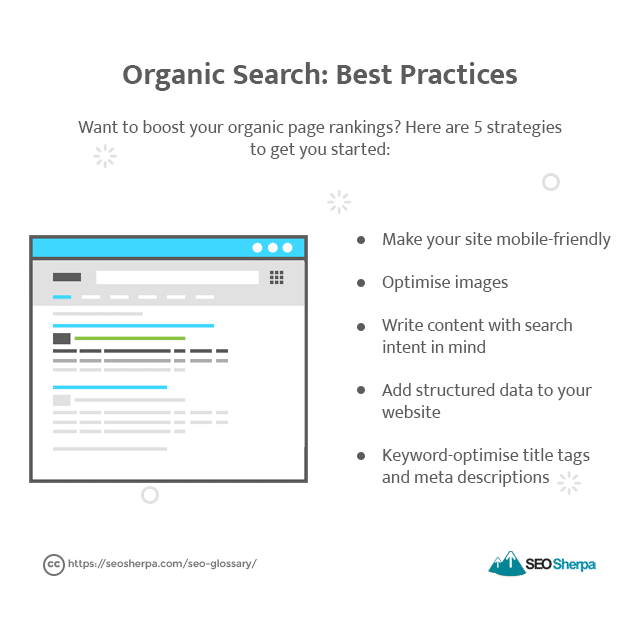

Paid Search Results
How does paid search results work?
Paid search results are listings that appear above and below organic search results in the search engine’s sponsored ad sections.
Businesses must go through a bidding process for specific keywords to be displayed in the sponsored ad section.
In the SERPs, paid search results are displayed with an “Ad” label allowing search users to differentiate between organic and paid search results.
Additional Resources:
- 5 Seriously Underused Paid Search Strategies by Asi Dayan
- How to Combine SEO & PPC Data for More Powerful Results by Ben Wood
PageRank
How does PageRank work?
A Google algorithm and ranking factor, PageRank is used to assess the quality and quantity of backlinks to your website.
PageRank determines the importance of a web page by specifying the page’s links based on relevance, reliability, and authority. The higher the PageRank score, the better a page will rank in the search results.
Additional Resources:
- Google PageRank, Simplified: A Guide for SEO Beginners by Dave Davies
- Everything You Need to Know about Google PageRank by Erika Varagouli
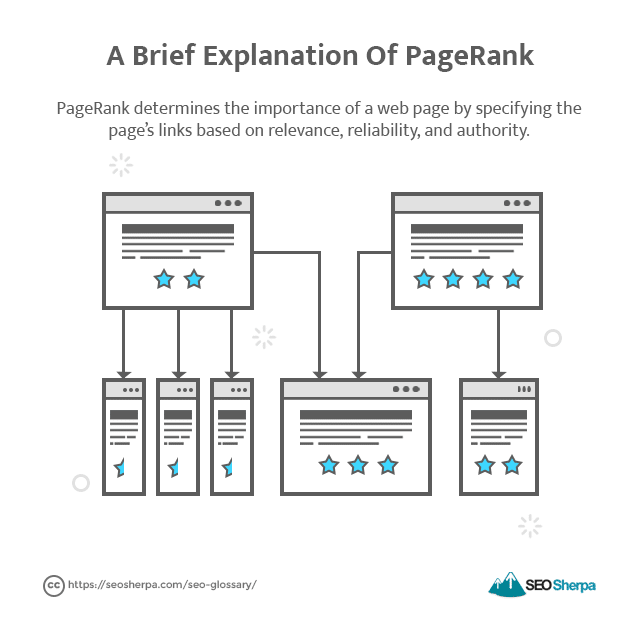
Page Speed
How does Page Speed affect SEO?
Page Speed is a metric that refers to how long it takes a web page to load all of its content. Page speed is a ranking factor as website load time impacts user experience.
The faster your website loads, the longer visitors stay on your site. This can result in more conversions and higher rankings.
Additional Resources:
- PageSpeed Insights by Google
- Page Speed and SEO by Brian Dean
- How to Improve Page Speed for More Traffic & Conversions by Jeremy Knauff
- Page Speed: 15 Quick Fixes for Decreasing Web Page Load Times by James Reynolds

Pay-Per-Click
How do I use PPC advertising?
Pay-per-click (PPC) is an advertising and marketing model used by businesses to improve their visibility in Google’s SERPs.
PPC works on an ad auction process. Meaning, businesses compete with other advertisers to have their ads appear more prominently above Google’s organic search results.
The ad auction is an automated process based on the ad account’s eligibility, maximum cost-per-click, quality score, and other factors.
Additional Resources:
- What is paid search (PPC) and why do you need it? by Rebecca Sentance
- An Introduction to PPC Marketing by James Brockbank
- The Ultimate Guide To PPC by PPC Hero
Persona
How do I create buyer personas for my business?
Buyer or user personas are semi-fictional representations of your target audience(s). Persona profiling helps your business better determine what people search for and what their pain points are.
This allows you to create highly-personalised content and marketing strategies that target your ideal customer.
The more your content resonates with your target audience, the more success your marketing strategies will have.
Additional Resources:
- The Science of Understanding the Person Behind the Visit by Michael King
- Here Are 10 Buyer Persona Examples to Help You Create Your Own by Kim Kosaka

Query
What is a search query?
A search query is the words or phrases that a search user will type into a search engine box to generate a list of results. Search queries typically include focus keywords to narrow the list of results further.

Ranking Factor
What are the ranking factors in SEO?
Search engines use specific metrics, called ranking factors, to categorise how web pages get ranked in search results. Google uses over 200 ranking factors to determine your site’s SERP position for various search queries.
Additional Resources:
- How Search Algorithms Work by Google
- Google’s 200 Ranking Factors: The Complete List (2020) by Brian Dean
Reciprocal Link
Do reciprocal links negatively affect my site’s SEO?
Reciprocal links (or link exchanges) refers to an “I scratch your back, you scratch my back” agreement between two site owners.
Both parties link to each other because the services or products are complementary to each other. Or because the recommendation serves to benefit both site’s audiences.
The practice of link exchanging is done because backlinks are a ranking factor and links from high-quality, authoritative sites can bolster a site’s authority and, ultimately, its ranking position.
Google and other search engines warn that excessive link exchanges for the sake of cross-linking is a manipulative SEO practice and can result in a manual action.
Additional Resources:
- Reciprocal Links: Do They Help or Hurt Your SEO? by Julia McCoy
- The Truth About SEO Reciprocal Linking in 2019 by Helvis Smoteks
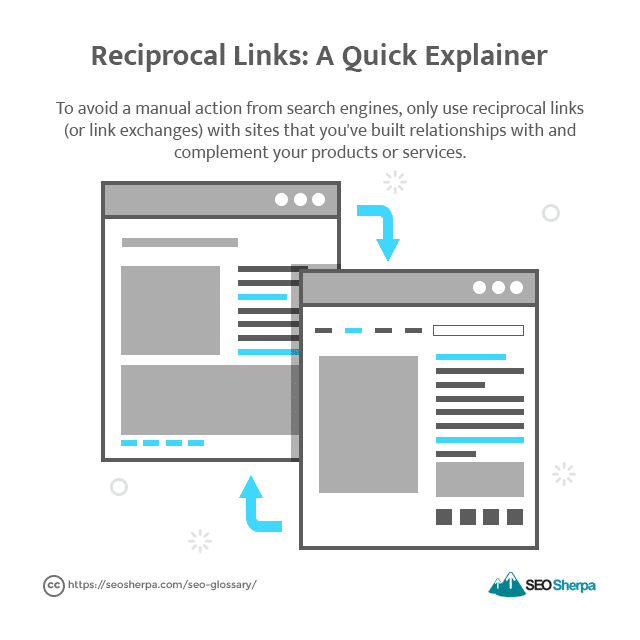
Relevance
What is relevance in SEO?
Relevance refers to how closely your site’s content or information aligns to a search query. The more relevant your site’s content is to a given search query, the higher your site appears in the SERPs for that search result.
Additional Resources:
- The Three Pillars of SEO: Authority, Relevance, and Trust by Mark Traphagen
- Why Relevancy Matters For SEO Optimisation by Stephanie Barnes
Reputation Management
How can I best manage my online reputation?
Reputation management or online reputation management is the practice of cultivating a positive online reputation to build brand trust and loyalty, resulting in increased exposure and conversions.
Several ways to monitor and manage online reputation is by conducting brand searches, creating Google alerts, and being proactive with customer engagement.
Additional Resources:
- Online Reputation Management: What It Is & Why You Need It by AdEspresso
- A 5‑Step Online Reputation Management Guide by Tim Soulo
Rich Snippets
How do I get rich snippets for my business?
Rich snippets (also called rich results) are additional information displayed alongside your brand’s standard organic search data such as title tag, URL, and meta description.
To display rich results, your website needs to include a structured data markup in its HTML.
Additional Resources:
- Understand how structured data works by Google
- Why You Need Rich Snippets in Your Life by Aaron Agius
- The Comprehensive Newbie-Friendly Guide To Rich Snippets by Karl Tablante
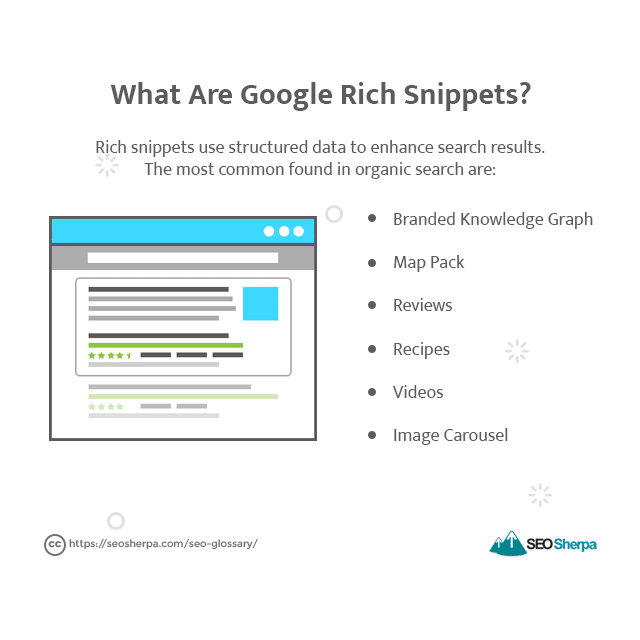
Robots.txt
What is a robots.txt file?
Robots.txt is a text file that contains a set of instructions for a search engine’s crawlers. Crawlers or spiders use a robots.txt file to determine which pages of a website should be crawled and indexed.
A robots.txt file is used to maximize the crawl budget and specify which pages on a site should and should not be crawled.
Additional Resources:
- Create a robots.txt file by Google
- Robots.txt: The Ultimate Guide for SEO by James Reynolds
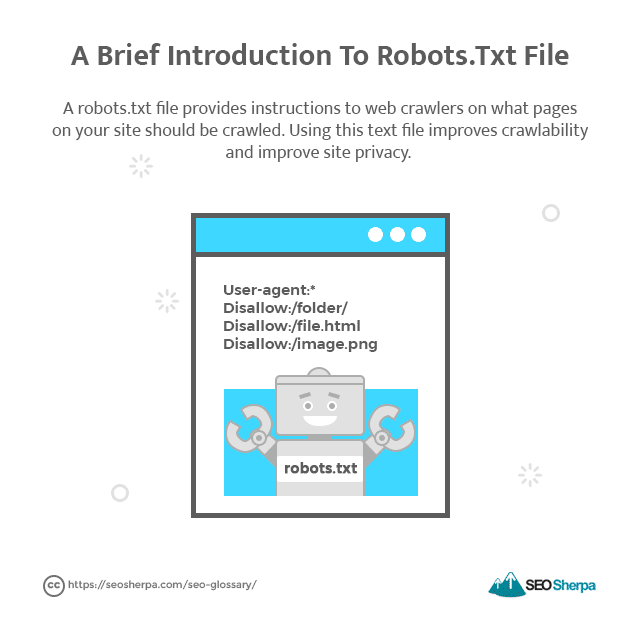

Schema Markup
Why is schema markup important for SEO?
Schema markup is a type of structured data vocabulary that helps search engines better your site’s web pages. Search engines like Google use schema markup to display rich snippets.
Additional Resources:
- Getting started with schema.org using Microdata by Schema.org
- What Is Schema Markup & How to Add it to Boost SEO by Melissa Smith

Scraping
What role does scraping have in your SEO efforts?
Scraping is a type of data extraction technique that uses an automated computer program to gather metadata from websites or other sources on the web.
Scraping is done for several purposes, such as competitor research and marketing analysis. Search engines also scrape websites to develop their indices.
Additional Resources:
- Web Scraping for SEO with these Open-Source Scrapers by AnnexCore
- 6 Actionable Web Scraping Hacks for White Hat Marketers by Joshua Hardwick
- 3 SEO issues which can be solved with data scraping by Nicolas Duverneuil
Search Engine Marketing
What is search engine marketing?
Search engine marketing (SEM) is the process of using paid advertising strategies to improve a site’s visibility in search results.
By paying for ads, businesses have the opportunity to appear above organic search results for search terms that relate to their targeted keywords.
Additional Resources:
- SEM: Tips, Benefits, & How It Relates to SEO by Nicole Rende
Search Engine Optimisation
What is search engine optimisation & why is it important?
Search engine optimisation (SEO) is the process of ranking a website at the top of Google’s SERPs, making it one of the first sites found by search users. Statistically, the higher a site is in the SERPs, the more clicks it will receive.
Websites must use a combination of on-page (content and technical) and off-page (link building and marketing) SEO strategies to improve their visibility in organic search results.
- SEO Basics: A Simple Step-by-Step Guide for Beginners by Karl Tablante
Search Index
How does a search engine index work?
A search index refers to a search engine’s database. When a web page is crawled, the data and information on that page are collected, parsed, and stored in the search index.
The information collected is organised by key signals outlined by the search engine.
Once a search query is performed, the search engine accesses its database to find web pages to display in its SERPs based on relevance to the search term.
Additional Resources:
- How to Submit Your Website to Google (And Why It Matters) by Jeffrey Vocell
- Google Index: How long does indexing take? by Ramona Sukhraj
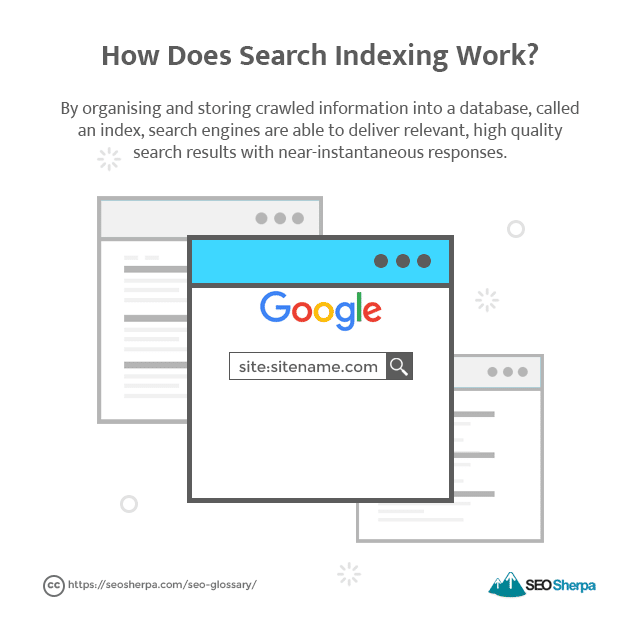
SERP
What does SERP stand for?
A search engine results page (SERP) is the web page that is served to a search user by a search engine like Google. SERPs present the results of a search query.
Search results are customised according to several factors like the user’s geographical location, search intent, browsing history, and more.
Additional Resources:
- A guide to every 2020 Google SERP feature by Michael O’Neill
- Breaking Down SERPs to Increase SEO Results by Erik Newton
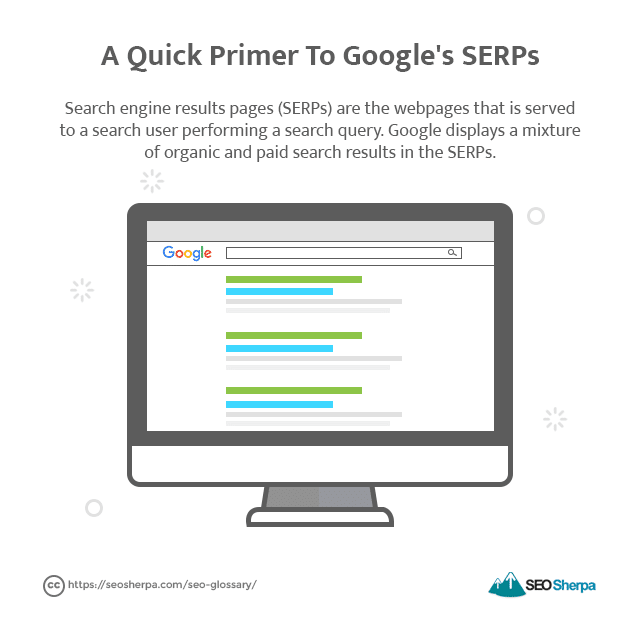
Search Intent
What is search intent?
Search intent (also known as user intent) is the reason behind why someone would perform a specific search query.
The better organised and more relevant your site’s content is to particular search queries, the higher it will rank in search results. There are four primary types of search intent to consider:
- Information: The search user is looking for specific information (Example: who is the president of the united states?)
- Navigational: The search user wants to visit a specific destination or website (Example: Facebook)
- Transactional: The search user is looking to purchase a particular product or service (Example: buy nike shoes)
- Commercial investigation: The search user is looking to make a purchase shortly (Example: best basketball shoes)
Additional Resources:
- What is search intent? by Marieke van de Rakt
- What is Search Intent and Why Does it Matter? by Sidra Condron
- Understanding & Fulfilling Search Intent by Britney Muller
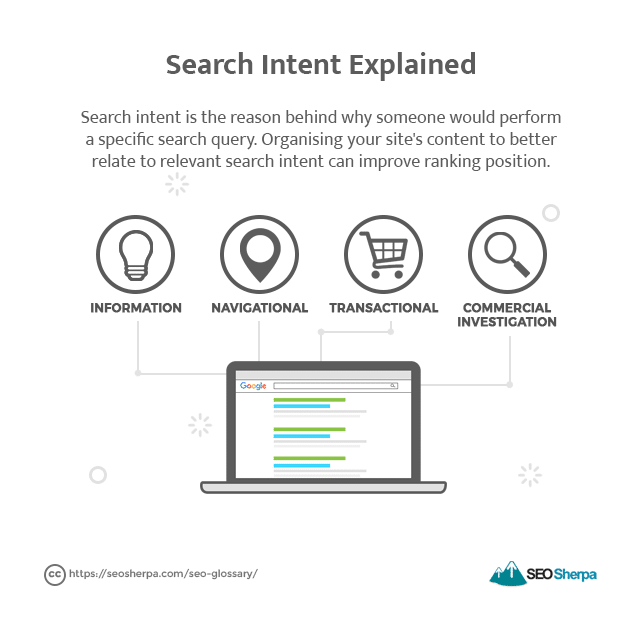
SERP Features
How to get SERP features?
Google’s SERP features are additional interactive elements found in Google’s search results. SERP features change over time as Google improves user experience and resolves to answer queries with as little clicks possible.
The most popular SERP features include:
- Featured Snippet (Instant Answer)
- Local Pack
- Reviews
- Sitelinks
- Videos
- Top Stories
- Images
- Knowledge Panel
- FAQs
- People Also Ask (Related Questions)
- Google Flights Block
- Hotel Pack
- Job Listings
Additional Resources:
- 2020 Ultimate Guide to Google SERP Features by John E. Lincoln
- An Overview of Common Google SERP Features by Emily Hogarth
- Ranking For Google’s Featured Snippets In 6 Easy Steps by James Reynolds
Social Signal
How do social signals affect SEO?
Social signals are engagement metrics (likes, shares, views, etc.) on social media platforms like Twitter, Facebook, and Instagram.
Social signals act as a form of endorsement for search engines, influencing brand authority and impacting ranking positions.
Additional Resources:
- How social media signals impact your SEO results by Andrew Shipp
- Do Social Signals Matter For SEO In 2020 by Samantha Hackett
Split Testing
Why should you split test your web page or landing page?
Split testing, also known as A/B or multivariate testing, is the practice of comparing different versions of a web page or landing page to improve conversions.
By using a control (original) and variation page, testers can analyse with page version converts the best. Typical page elements that testers experiment with during split testing include:
- Headline
- Copy
- Content depth
- Call-to-actions
- Search box placement
- Image or video variations
Additional Resources:
- How to do A/B Testing and Improve Your Conversions Quickly by Neil Patel
- How to Create a Split Test (and Why You Should) by Sharon Hurley Hall
SSL Certificate
How important is an SSL certificate for my site?
A Secure Sockets Layer (SSL) certificate is a data file that encrypts communication between a web browser and a web server. Sites are now required to have an SSL certificate to competitively rank in the SERPs.
Additional Resources:
- A Beginner’s Guide to SSL by Jeffrey Vocell
- 6 Options for SSL Certificates to Secure Your Website by Jennifer Walsh

Subdomain
What is a subdomain?
A subdomain is a URL extension used by websites to separate and organise different sections distinct from the root domain. The subdomain appears before the second-level domain (the site’s name) in the URL.
In the URL, https://store.example.com, store would be the subdomain.
Websites use subdomains for various functions such as creating a multilingual site, running a separate eCommerce store, and testing plugins or updates on a staging site.
Additional Resources:
- How to Optimize Your Subdomain With SEO by WebFX
- What is a subdomain and how does it impact SEO? [Infographic] by Jeff Keleher
Subfolder
What is a subfolder?
Like a subdomain, a subfolder is a type of directory structure that allows websites to create different sections of a website.
Subfolders differ from subdomains in that a subfolder is not distinct from the root domain but rather a pathway in the site’s hierarchy.
Additional Resources:
- Subdirectories vs. Subdomains for 2019 and Beyond by Evan Hall

Taxonomy
What is website taxonomy?
Taxonomy is a classification system used by websites to structure web pages into content silos. Optimising URL taxonomy improves site navigation, search engine crawlability, and user experience.
Additional Resources:
- A Guide to Site Taxonomy and Its Effect on SEO by Mitul Gandhi
- Categorising a Website & Defining Taxonomies by Rachel Costello

Title Tag
Why do title tags matter for SEO?
A title tag is an HTML indicator that defines which text is the title of the page. In the HTML code, title is displayed as <title> and </title> tags.
The title tag appears in Google’s SERPs as the clickable blue link above the page URL and at the top of a browser tab. Title tags should be between 50-60 characters to ensure none of the text gets truncated.
Additional Resources:
- How to Write Title Tags: An SEO Step-by-Step Guide by Luke Harsel
- How to craft great page titles for SEO by Joost de Valk
- Title Tags: The Definitive Guide To Meta Titles For SEO by James Reynolds
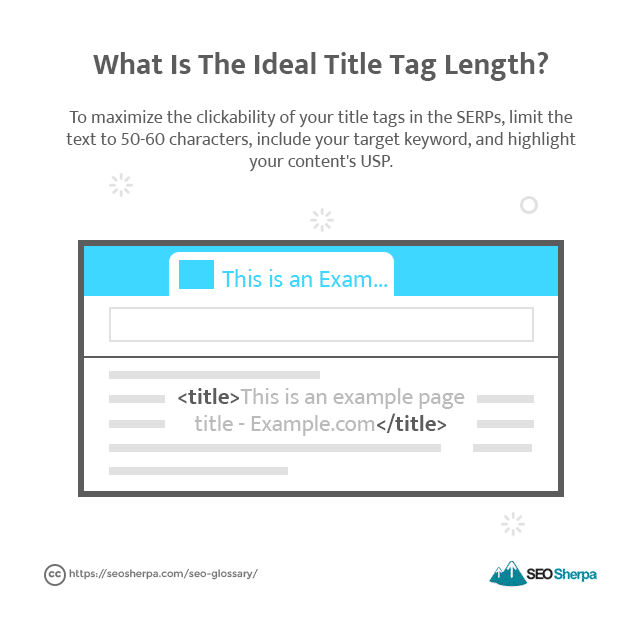

User-Generated Content
Does user-generated content improve SEO?
User-generated content (UGC) is any type of content, from social media posts to reviews, that is voluntarily created by the individuals and fans of a brand rather than the brand itself.
UGC creators have no affiliation with the brand in question.
Additional Resources:
- User Generated Content: 5 Steps to Turn Customers Into Advocates by Alex York
- User-Generated Content: Why It’s Effective and How to Use It by Ted Vrountas
URL
What does URL stand for?
Uniform Resource Locator (URL) or web address specifies the location of a certain resource like a website, web page, or file (image, video, document, etc.) A URL has three primary components:
- Protocol (http:// or https://)
- Domain name (seosherpa.com)
- Path to a specific web page (seosherpa.com/blog/)
Additional Resources:
- URL Structure [2020 SEO Best Practices] by Moz
- SEO Friendly URLs by Brian Dean
- URL Slugs: How to Create SEO-Friendly URLs (10 Easy Steps) by James Reynolds

Usability
How do you evaluate a site’s usability?
In web design, usability refers to how easily and efficiently visitors can interact with your website.
A website that ranks high in the usability scale has clear navigation, high readability, quick load time, and is mobile responsive.
Additional Resources:
- The 16 Website Design Best Practices For Conversions by Neil Patel
User Experience
How important is UX for SEO?
User experience, or UX for short, is a broad term that describes the end-user interaction with a product or service. UX takes into consideration many elements ranging from usability and accessibility to ease of use.
Additional Resources:
- What’s the importance of User Experience in web design? by BOSS Magazine
- The 7 Factors that Influence User Experience by Interaction Design Foundation
- Refining your website’s user experience in 3 steps by Ezgi Cetinkaya

Vertical Search Engine
What is a vertical search engine?
A vertical search engine refers to a dedicated search engine that is focused on a particular niche or segment of online content. Examples of vertical search engines include:
- YouTube (video search engine)
- Google Images (image search engine)
- Monster (employment search engine)
- Amazon (product search engine)
- Skyscanner (air travel search engine)
Additional Resources:
- Search is more than Google: Mastering vertical search optimization by Jim Yu
- Vertical Search Optimization & What You Should Know by Erik Newton
Voice Search
What is voice search?
Voice search is a type of voice-activated search that makes use of speech recognition technology and natural language processing to allow search users to perform a verbal search query on a device like a smartphone.
Additional Resources:
- Top Voice Search Statistics, Facts And Trends For 2020 by Asad Butt
- 5 Voice Engine Optimization Strategies to Get Ahead by Loren Baker

Web Page
What is a web page?
A web page is an HTML-formatted document viewed on a web browser. Web pages are accessed by their URLs, entered into the web browser’s address bar or by clicking on a hyperlink.
A web page can contain different types of content from text and graphics to files. A collection of web pages make up a website.
Additional Resources:
- Infographic: How To Write SEO Content That Ranks by Karl Tablante
Webmaster Guidelines
What are webmaster guidelines?
A search engine provider’s webmaster guidelines are a list of rules and procedures that webmasters must follow to ensure their website can be crawled, indexed, and ranked by the search engine.
A breach of webmaster guidelines can lead to the website being devalued or even excluded from the search engine’s index.
Additional Resources:
- Google Webmaster Guidelines by Google
- Bing Webmaster Guidelines by Bing
White Hat SEO
What is the importance of white hat SEO?
White hat SEO makes use of various search strategies that adhere to a search engine’s guidelines. Unlike black hat SEO, which manipulates search rankings, white hat SEO uses ethical practices to perform well in the SERPs.
Popular white hat SEO strategies include:
- Keyword research
- Creating high-quality, relevant content
- Optimising site load times
- Using keyword-rich, descriptive meta tags
- Improving the site’s user experience
- Prioritising mobile-first indexing
Additional Resources:
- White Hat SEO: How to Play by the Rules and Win by Tim Soulo
- 7 White Hat SEO Techniques to Double Traffic by Chuck Price

XML Sitemap
What is an XML sitemap?
An Extensible Markup Language (XML) Sitemap is a type of text file that helps search engine crawlers find and index your site’s web pages. XML sitemaps are necessary for the following types of websites:
- Large websites
- Websites with large archives
- New websites with few external links
- Websites with rich media content
Additional Resources:
- The importance of XML sitemap in SEO by Emma Labrador
- XML Sitemaps: The Most Misunderstood Tool in SEO by Michael Cottam
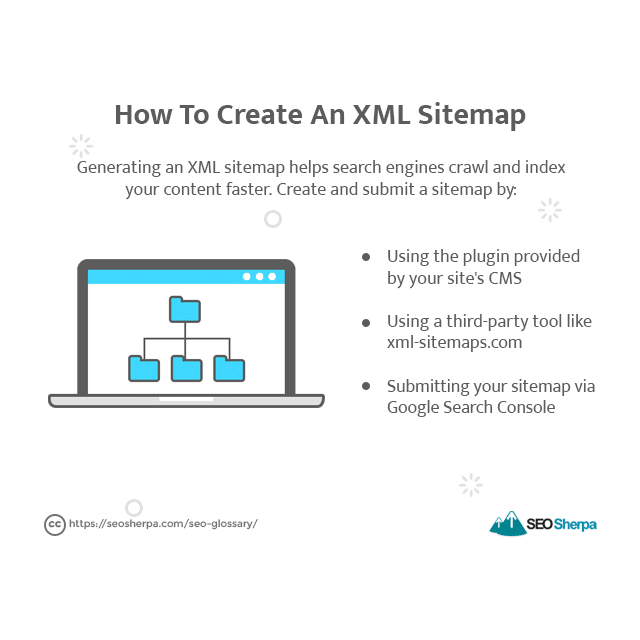

YMYL
What is YMYL and why is it important for SEO?
YMYL is an acronym that stands for Your Money or Your Life. Like E-A-T, YMYL is a quality rating score. YMYL is focused on content that affects a search user’s health, safety, or financial stability.
Site categories that are considered as YMYL include:
- News and current events
- Civics, governments, and law
- Finance
- Shopping
- Health and safety
- Fitness and nutrition
- Groups of people
Additional Resources:
- A no-nonsense guide to using YMYL and E-A-T in SEO by Chris Pitt

Zero Click Search
What is a zero click search?
A zero click search occurs when the answer for a search query is provided directly within the SERPs. Since the search results immediately satisfies search intent, the user does not require any further clicks to complete the query.
Additional Resources:
- How to Successfully Do SEO for Zero-Click Searches by Viola Eva
- What Are Zero-Click Searches? by Jolissa Skow
Ready to put this SEO glossary to good use?
While this list of SEO definitions is not the most exhaustive, you’ll find every commonly used term and meaning worth knowing.
If there are words or phrases you’d like us to add to our glossary, don’t hesitate to shoot us a message in the comments below. We also update this SEO glossary with new terms and definitions on an ongoing basis, so be sure to bookmark this page.
This glossary is also available as a free ebook, outlined in an easy-to-read format to maximise your SEO learning.
Download your copy below!
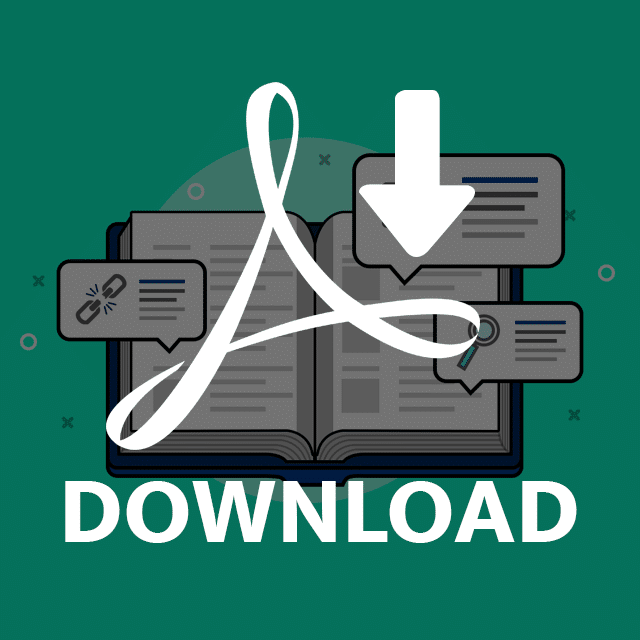
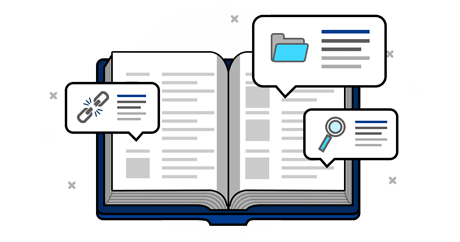
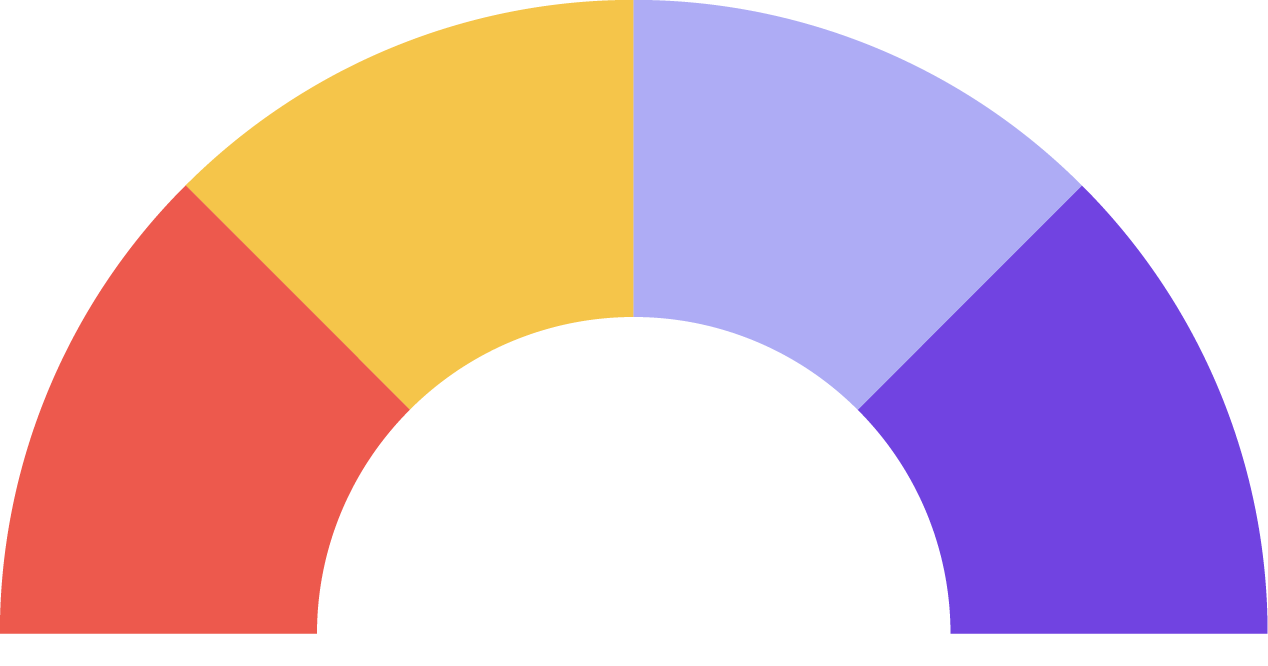
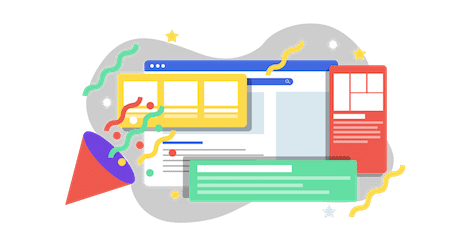

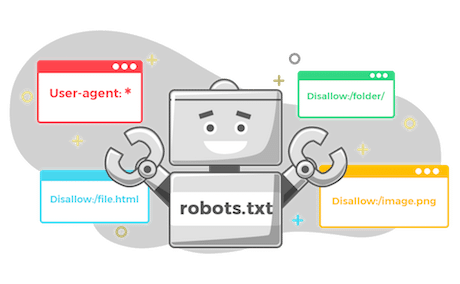

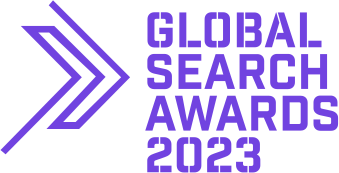


Leave a Reply